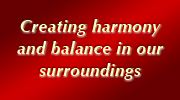|
|

|

|

|

|

|

|

|

|
|
|
||
|
|
||
|
|
|
Wood: The Element of Spring by Carol C. WheelockAs the winter winds down, most of us are looking forward to a change in the seasons. This much-anticipated shift to longer days, buds on trees, and more warmth leads many to get up earlier, clear clutter, and/or make exciting plans for a new adventure. Spring is traditionally a time of new beginnings, renewal, growth, and hope. In feng shui there are five elements: water, wood, fire, earth, and metal. They are all equally important and play a role in how a space feels, which influences how people behave and feel in that space. As always, the goal is to support balance. Each of these elements is associated with a direction, time of day, and a season. Wood is the element of the east, early morning, and spring. It has an outward moving energy -- just envision the growth of trees. It is represented by wood itself, the color green, columnar shapes, all indoor and outdoor plants, plant-based textiles, floral fabrics, and art depicting landscapes, gardens, etc. When the amount of wood in an environment is balanced it supports growth, flexibility, expansion, and nourishment. These spaces support good interaction, activity, and exploration. They have room for people to move effectively. An environment with balanced wood energy is energizing. What happens if the amount of wood in an environment is out of balance? As with all of feng shui, if there is an imbalance in the environment, there will be imbalances within those who live or work there. If there is a lack of wood, growth tends to be stagnated. Things just don't happen. It is easy to balance these spaces by bringing in green plants, columnar shapes, etc. On the other hand, if there is too much wood, people tend to feel overwhelmed and over committed. The classic example is the log cabin. For the majority of people, a log cabin is too much wood, especially if it is situated in a wooded environment. (In addition, all the brown and horizontal earth energy adds to the stuck feeling of going nowhere.) Wood paneling is another example. Avoid using the color green or floral fabrics in these situations. There are many other ways to bring these environments into balance, but they are more involved and depend on an understanding of the other elements. The same five elements comprise a person's personality. People who have a predominant wood element are those who are the go-getters. They are active and often athletic. They are the planners, the initiators -- people who foster new growth. Just as a space can be out of balance, a person can be also. Too much wood, especially for a wood personality, can make that person overly driven. Too little, and the motivation just isn't there. The elements are also connected with the bagua, the grid that is superimposed upon any space, indicating which areas correspond with specific aspects of life. Wood is associated with prosperity, and health and family. Both of these areas are dependent on growth, nourishment, and the other qualities associated with the wood element. Spring is the perfect time to look at the amount of wood in your work and home environments. If there is too much, paint and/or a change in fabrics can make a huge difference. If there is too little, increase the amount of wood by bringing in more of the wood qualities.
It is also the perfect time of year to assess houseplants. They are only supportive if they appear healthy and vital. Compost the unhealthy ones and buy or start a new plant. It's a wonderful way to honor the spring and invite new growth into your life. As you do this, remember to state your intentions for this season of renewal.
Carol C. Wheelock |
|
|
|
||

|
||

|